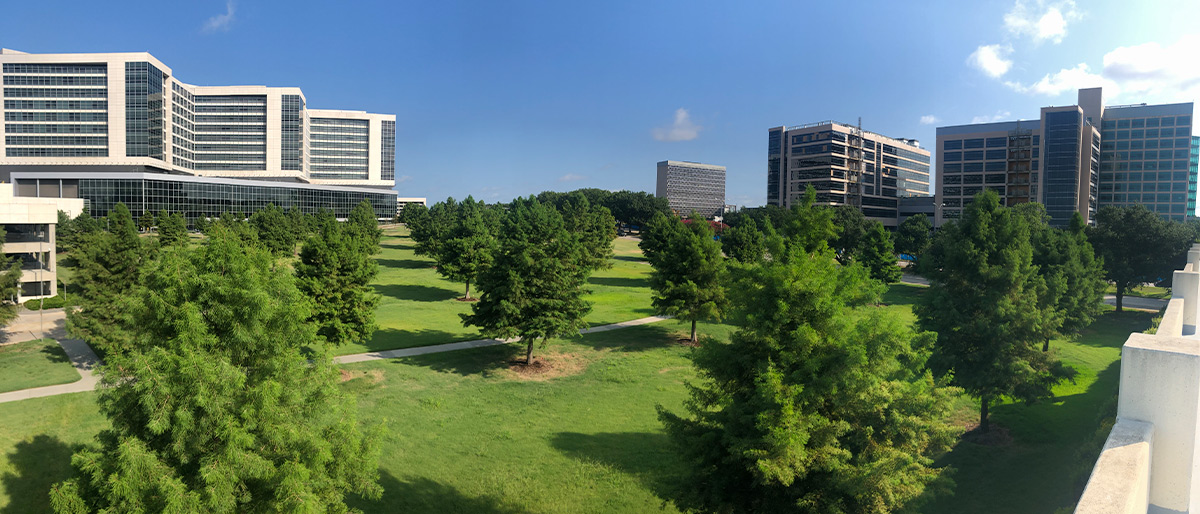UT Southwestern enhances environmentally conscious initiatives

UT Southwestern’s efforts to reduce its carbon footprint can be seen in the variety of campus sustainability measures, including energy and water conservation programs and solid waste reduction initiatives, along with the expanded use of native plants, a lush tree canopy, and Monarch butterfly-friendly landscaping.

“When you look at the big picture, it’s a green island surrounded by concrete,” said Juan Guerra Jr., Vice President of Facilities Management.
A closer look reveals even more ways in which UT Southwestern endeavors to be environmentally focused, said Daniel K. Podolsky, M.D., President of UT Southwestern.
“Our campus Sustainability Committee actively monitors and initiates a variety of sustainability measures, including energy and water conservation and solid waste reduction initiatives,” Dr. Podolsky shared in a recent campus briefing. “In Facilities Management, we have many processes and programs aimed at reducing greenhouse gas emissions. We also have robust recycling and reuse programs to reduce our solid waste stream.”
UT Southwestern actively looks for opportunities to conserve energy, Mr. Guerra said.
“Over the past 10 years, energy consumption has been reduced about 12% per square foot,” he said.

Boilers are tested monthly to ensure all emissions are within federal and state regulatory guidelines. In addition, old steam boilers were recently replaced at the North and South Thermal Energy Plants with higher efficiency units that have low greenhouse gas emissions potential.
“We do everything we can to minimize air emissions,” Mr. Guerra said.
UT Southwestern also applies LEED (Leadership in Energy and Environmental Design) green building standards when designing and constructing all new facilities.
Recycling also plays a role in reducing the carbon footprint. In fiscal year 2020, UT Southwestern recycled an estimated 750 tons of mixed recycling, which equates to an 11% reduction in waste from 2016 to 2020.

The Blue Bin Recycling Program has grown over the years to accommodate mixed recycling for paper, cardboard, envelopes, newspapers, magazines, file folders, plastic materials, cartons, and aluminum cans. Efforts to recycle plastic foam products are underway.
In hospital and clinical areas, the hospital’s “Green Team” focuses on areas to improve the overall sustainability impact, said Donald McLaughlin, Associate Vice President of Hospital Clinical Operations. The team focuses annually to improve overall sustainability impact and align with the overarching UT Southwestern Sustainability Steering Committee.
“We implemented a program at William P. Clements Jr. University Hospital in which we no longer place sheets on an empty bed until a patient is admitted,” Mr. McLaughlin said. This led to a reduction of 498,016 pounds of linen used annually at Clements and Zale Lipshy Pavilion.
Clements University Hospital also increased usage of a shredding recycling program (the shredded material is recycled by a company providing this service). The reduction of waste equated to 1,810 trees saved for the last fiscal year, he said.
Environmentally friendly landscaping efforts include planting native and adaptive plants that tolerate Texas weather and require less watering. To maintain soil moisture and reduce disposal of landscaping trash, all mulch is made from recycled plant materials. Also, an arborist manages the landscaping to protect the trees during extreme weather, Mr. Guerra said. These efforts have earned UT Southwestern recognition as a 2020 Tree Campus Healthcare Facility from the Arbor Day Foundation.
In addition, Monarch butterfly-friendly plants have been added to the landscaping to support the butterflies and provide migration waystations.

To further reduce the carbon footprint, carpooling and use of mass transit are highly encouraged on campus, and subsidized DART passes are available.
“Collectively we can make a huge difference by all the little things we do when we’re on campus, from turning off lights in empty rooms to reporting leaking faucets or using the stairs instead of elevators,” Mr. Guerra said.
Dr. Podolsky holds the Doris and Bryan Wildenthal Distinguished Chair in Medical Science, and the Philip O’Bryan Montgomery, Jr., M.D. Distinguished Presidential Chair in Academic Administration.

